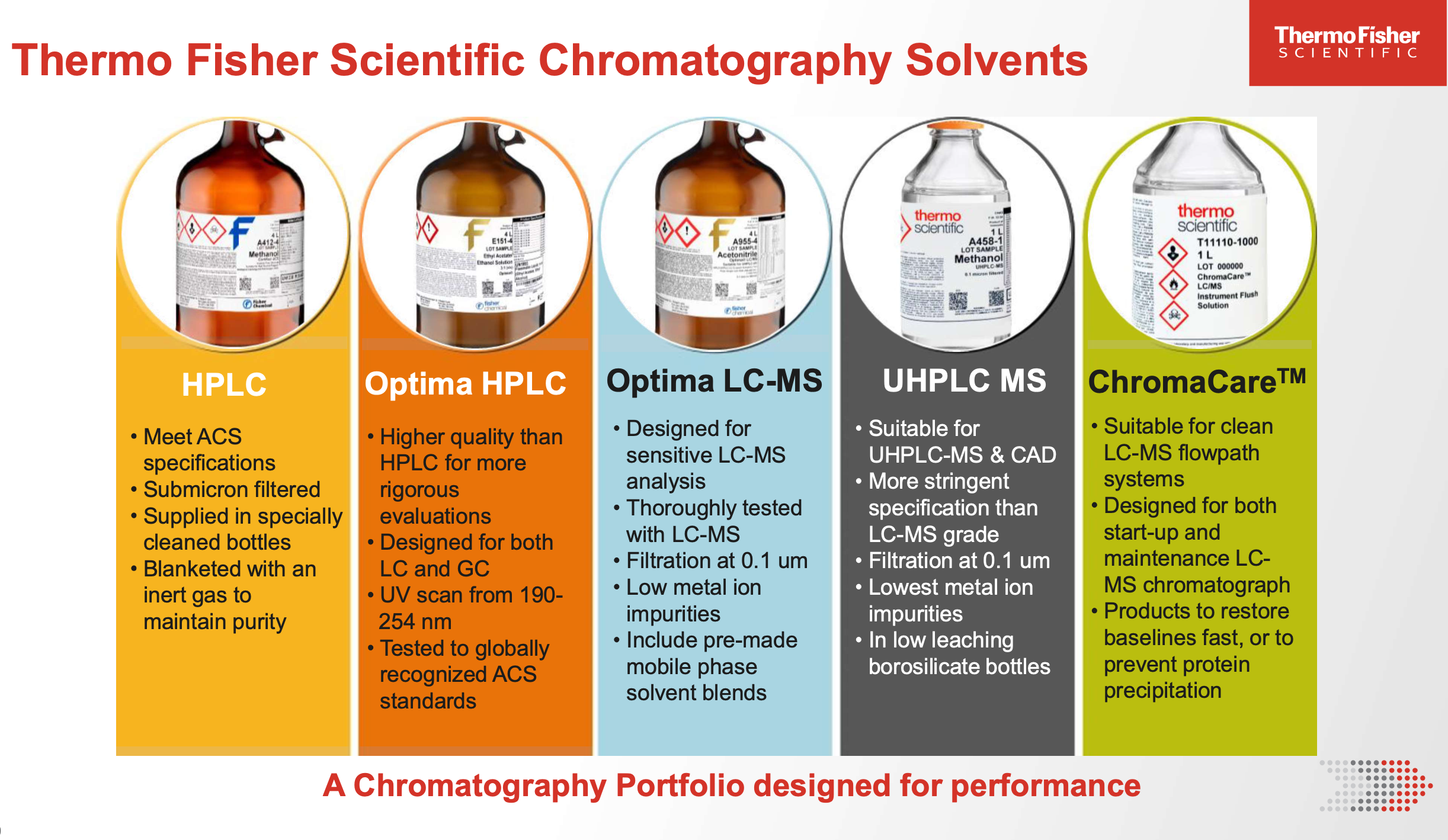The Difference of Solvent between HPLC, Gradient, and LC/MS
โครมาโตกราฟีของเหลวประสิทธิภาพสูง (HPLC) การไล่ระดับสี และโครมาโตกราฟีของเหลว-แมสสเปกโตรเมทรี (LC/MS) เป็นเทคนิคสามประการที่ใช้กันทั่วไปในเคมีวิเคราะห์ เทคนิคเหล่านี้ใช้ในการแยกและวิเคราะห์ส่วนผสมที่ซับซ้อนของสารประกอบ สิ่งสำคัญประการหนึ่งของเทคนิคเหล่านี้คือการเลือกใช้ตัวทำละลาย ซึ่งอาจส่งผลกระทบอย่างมากต่อการแยกและการตรวจจับสารวิเคราะห์ ในบทความนี้ เราจะสำรวจความแตกต่างในการเลือกตัวทำละลายระหว่าง HPLC, เกรเดียนต์ และ LC/MS
HPLC เป็นเทคนิคที่ใช้กันอย่างแพร่หลายในการแยกและการหาปริมาณสารประกอบในของผสม การเลือกใช้ตัวทำละลายใน HPLC มีความสำคัญอย่างยิ่ง เนื่องจากส่งผลโดยตรงต่อประสิทธิภาพในการแยกและความละเอียดของสารวิเคราะห์ ใน HPLC ตัวทำละลายหรือที่เรียกว่าเฟสเคลื่อนที่ โดยทั่วไปจะเป็นส่วนผสมของตัวทำละลายสองตัวขึ้นไป ตัวทำละลายเหล่านี้อาจเป็นแบบมีขั้วหรือไม่มีขั้ว ขึ้นอยู่กับลักษณะของสารวิเคราะห์ การเลือกตัวทำละลายใน HPLC ขึ้นอยู่กับความสามารถในการละลายสารที่วิเคราะห์ ความเข้ากันได้ของตัวทำละลายกับเฟสที่อยู่นิ่ง และความแข็งแรงของการชะละลาย ตัวทำละลายทั่วไปที่ใช้ใน HPLC ได้แก่ น้ำ, เมทานอล, อะซีโตไนไตรล์ และเตตระไฮโดรฟูแรน
เกรเดียนต์โครมาโตกราฟีเป็นเทคนิคที่เกี่ยวข้องกับการเปลี่ยนองค์ประกอบของเฟสเคลื่อนที่ในระหว่างกระบวนการแยก เทคนิคนี้มีประโยชน์อย่างยิ่งเมื่อต้องรับมือกับสารผสมที่ซับซ้อนซึ่งมีสารวิเคราะห์ที่มีขั้วหลากหลาย ในเกรเดียนต์โครมาโตกราฟี องค์ประกอบของตัวทำละลายจะค่อยๆ เปลี่ยนไปเมื่อเวลาผ่านไป เพื่อให้สามารถแยกสารวิเคราะห์ได้ดีขึ้น การเลือกตัวทำละลายในเกรเดียนต์โครมาโทกราฟีจะคล้ายกับทางเลือกใน HPLC โดยมีการเติมตัวดัดแปลงเกรเดียนต์ ตัวปรับค่าเกรเดียนต์เป็นตัวทำละลายที่ถูกเพิ่มในเฟสเคลื่อนที่เพื่อปรับความแรงของการชะของสารวิเคราะห์ ตัวดัดแปลงเกรเดียนต์ทั่วไปรวมถึงกรดฟอร์มิก, แอมโมเนียมอะซิเตตและกรดไตรฟลูออโรอะซิติก
LC/MS เป็นเทคนิคอันทรงพลังที่ผสมผสานโครมาโทกราฟีของเหลวเข้ากับแมสสเปกโตรเมทรี ใน LC/MS การเลือกใช้ตัวทำละลายเป็นสิ่งสำคัญสำหรับทั้งการแยกโครมาโตกราฟีและการแตกตัวเป็นไอออนของสารวิเคราะห์ ตัวทำละลายที่ใช้ใน LC/MS ควรเข้ากันได้กับแมสสเปกโตรมิเตอร์ และไม่ควรรบกวนกระบวนการไอออไนเซชัน ตัวทำละลายทั่วไปที่ใช้ใน LC/MS ได้แก่ น้ำ เมทานอล อะซีโตไนไตรล์ และกรดฟอร์มิก การเลือกตัวทำละลายใน LC/MS ยังขึ้นอยู่กับประเภทของแมสสเปกโตรมิเตอร์ที่ใช้ เนื่องจากแมสสเปกโตรมิเตอร์ประเภทต่างๆ มีข้อกำหนดที่แตกต่างกันสำหรับองค์ประกอบของตัวทำละลาย
High-performance liquid chromatography (HPLC), gradient, and liquid chromatography-mass spectrometry (LC/MS) are three commonly used techniques in analytical chemistry. These techniques are employed to separate and analyze complex mixtures of compounds. One crucial aspect of these techniques is the choice of solvent, which can significantly impact the separation and detection of analytes. In this essay, we will explore the differences in solvent selection between HPLC, gradient, and LC/MS.
HPLC is a widely used technique for separating and quantifying compounds in a mixture. The choice of solvent in HPLC is critical as it directly affects the separation efficiency and resolution of the analytes. In HPLC, the solvent, also known as the mobile phase, is typically a mixture of two or more solvents. These solvents can be polar or non-polar, depending on the nature of the analytes. The selection of solvents in HPLC is based on their ability to dissolve the analytes, their compatibility with the stationary phase, and their elution strength. Common solvents used in HPLC include water, methanol, acetonitrile, and tetrahydrofuran.
Gradient chromatography is a technique that involves changing the composition of the mobile phase during the separation process. This technique is particularly useful when dealing with complex mixtures that contain analytes with a wide range of polarities. In gradient chromatography, the solvent composition is gradually changed over time, allowing for better separation of the analytes. The choice of solvents in gradient chromatography is similar to that in HPLC, with the addition of a gradient modifier. The gradient modifier is a solvent that is added to the mobile phase to adjust the elution strength of the analytes. Common gradient modifiers include formic acid, ammonium acetate, and trifluoroacetic acid.
LC/MS is a powerful technique that combines liquid chromatography with mass spectrometry. In LC/MS, the choice of solvent is crucial for both the chromatographic separation and the ionization of the analytes. The solvent used in LC/MS should be compatible with the mass spectrometer and should not interfere with the ionization process. Common solvents used in LC/MS include water, methanol, acetonitrile, and formic acid. The choice of solvent in LC/MS is also influenced by the type of mass spectrometer used, as different types of mass spectrometers have different requirements for the solvent composition.

